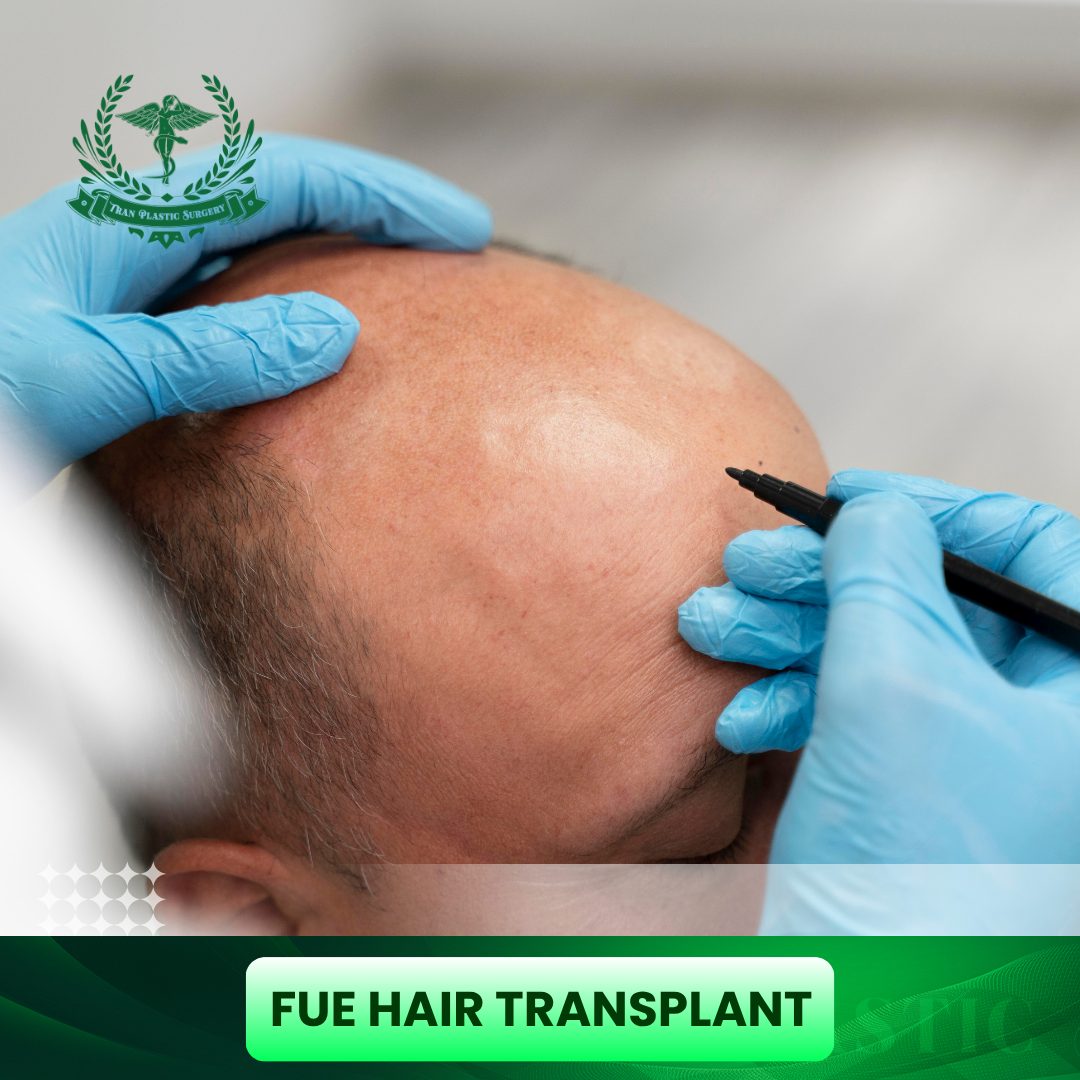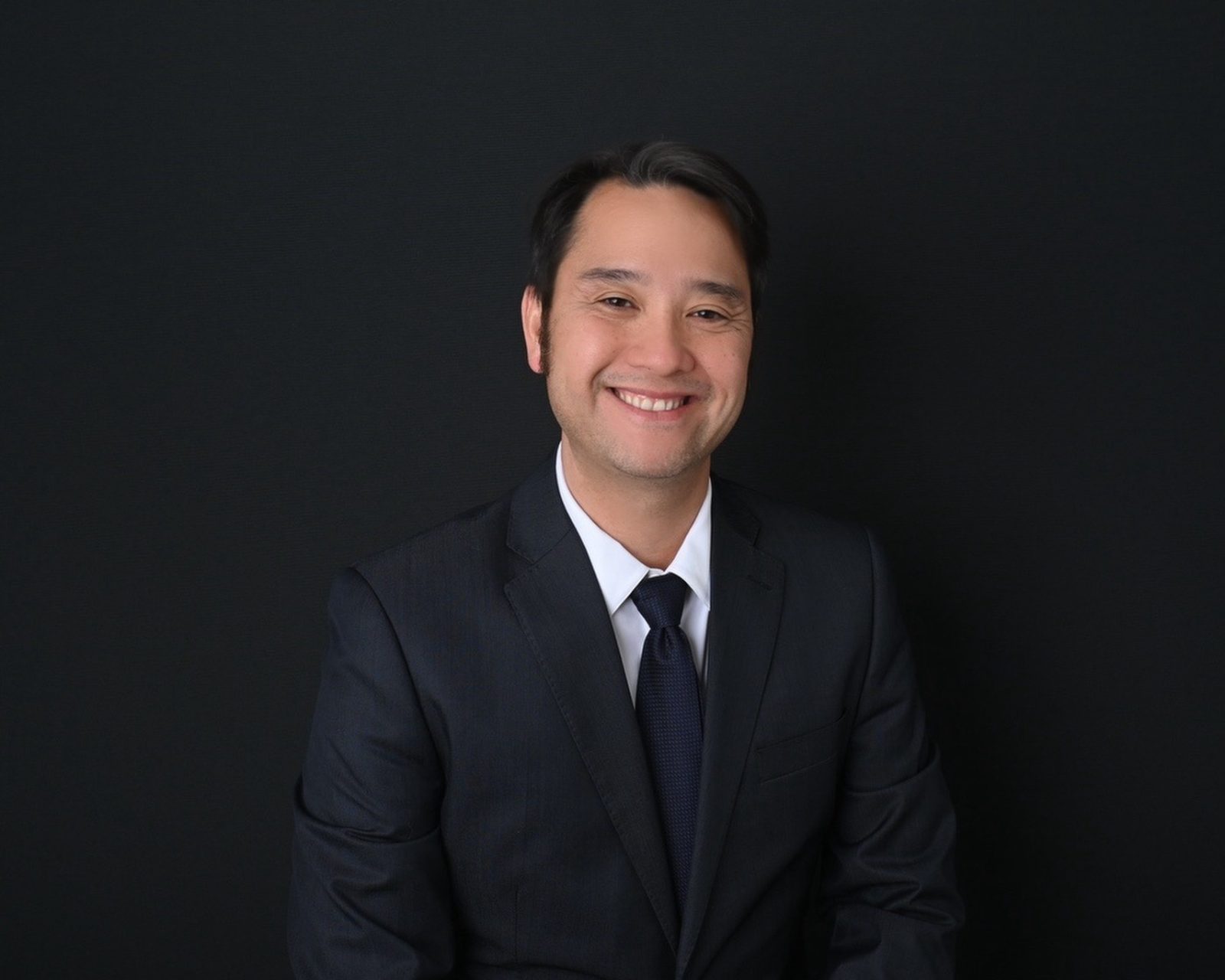FUE Hair Transplant isn’t just a medical procedure, it’s a life-changing solution for anyone who wants to restore confidence, youth, and a natural hairline. Imagine running your fingers through thicker, fuller hair again without worrying about scars or unnatural results. Thanks to modern FUE technology, that transformation is now within reach.
This guide reveals everything you need to know: how the FUE technique works, why it’s preferred over FUT and DHI methods, what to expect during recovery, real before and after outcomes, and how pricing is determined. If you’ve ever wondered whether a hair transplant can truly look natural and feel effortless, this article will give you the clarity and reassurance you’ve been searching for.
Table of Contents
ToggleWhat Is FUE Hair Transplant?
FUE Hair Transplant (Follicular Unit Extraction) is a modern, minimally invasive surgical technique used to restore natural hair growth in areas affected by thinning or baldness. During this procedure, individual hair follicles are carefully extracted from the donor area, usually the back or sides of the scalp and implanted into areas with hair loss. Each graft is placed with precision to match the natural direction, density, and angle of your existing hair, creating a seamless, realistic result.
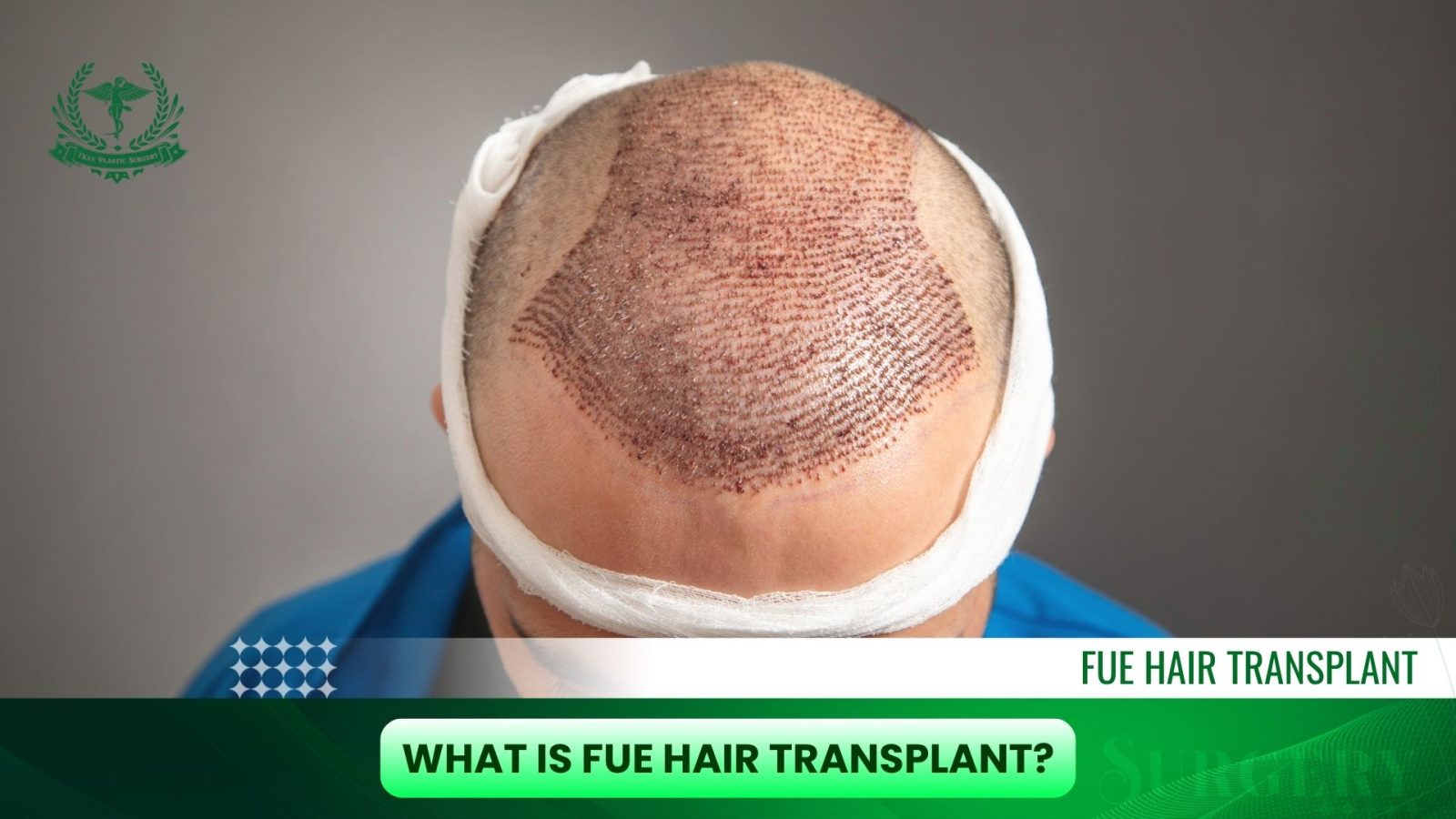
Unlike traditional strip methods such as FUT (Follicular Unit Transplantation), the FUE technique does not require stitches or leave a visible linear scar. This makes it ideal for patients who prefer short hairstyles or want a faster recovery time. The result is fuller, natural-looking hair that grows permanently and continues to improve over several months.
In modern plastic and aesthetic medicine, FUE Hair Transplant has become the gold standard in hair restoration surgery for men and women seeking a permanent, natural solution to hair loss. This advanced technique blends precision, safety, and artistry, enabling skilled surgeons to design hairlines that harmonize perfectly with each patient’s facial structure and aesthetic goals.
FUE Hair Transplant Cost – What to Expect in 2025
The FUE Hair Transplant cost in 2025 varies significantly depending on the country, clinic expertise, and number of grafts required. On average, international prices range between $2,000 and $8,000, while in the United States, the same procedure can cost $4,000 to $17,000+. The total investment depends on graft volume, surgeon experience, and the complexity of the FUE hair transplant procedure.
1. Average FUE Hair Transplant Prices by Region (2025)
| Region / Country | Average Cost (USD) | Typical Graft Range | Cost per Graft (Approx.) | Notes |
| United States | $4,000 – $17,000+ | 1,000 – 3,500 grafts | $4 – $10+ | Premium surgeons & advanced tech; higher operational costs |
| United Kingdom | $4,000 – $12,000 | 1,000 – 3,000 grafts | $3.50 – $8 | Strong regulations, mid-to-high cost range |
| Turkey | $2,000 – $6,000 | 2,000 – 4,000 grafts | $0.50 – $2 | Popular for medical tourism, competitive pricing |
| Europe (Other) | $3,000 – $8,000 | 1,500 – 3,500 grafts | $2 – $5 | Varies by country (Spain, Poland, Hungary, etc.) |
| Asia (Thailand, India) | $1,800 – $5,000 | 1,500 – 4,000 grafts | $0.80 – $2 | Affordable with growing international quality standards |
| Mexico / Latin America | $2,500 – $6,500 | 1,500 – 3,000 grafts | $1 – $3 | Strong reputation for cost-effective FUE packages |
2. Factors Influencing FUE Hair Transplant Cost
Several key elements determine the final price of an FUE Hair Transplant procedure. Understanding these factors will help you make an informed and transparent decision.
2.1. Cost per Graft
In the U.S., the cost per graft usually ranges from $4 to $10 or more, depending on the clinic’s standards and technology. Some clinics offer bundled pricing that includes consultation, surgery, and follow-up care, while others charge per graft.
2.2. Number of Grafts
The total cost directly depends on how many grafts are required to reach your desired density. Smaller procedures (e.g., 800–1,000 grafts) are less expensive than full scalp restorations requiring 3,000+ grafts.
2.3. Surgeon’s Experience and Reputation
Highly skilled and board-certified surgeons often command higher fees. However, their advanced expertise, artistic approach, and consistent results justify the investment. Reputable clinics with a strong track record typically deliver more natural outcomes and a higher graft survival rate.
2.4. Location and Regional Market
Pricing varies widely between regions. In the U.S. and Western Europe, operational and labor costs drive prices higher. By contrast, countries such as Turkey, Thailand, and Mexico are well-known for offering high-quality procedures at more affordable rates making them top choices for medical tourism.
2.5. Clinic Technology and Facilities
Modern clinics equipped with cutting-edge tools, such as the ARTAS robotic system or sapphire FUE instruments, may charge more due to the advanced precision and comfort these technologies provide. The overall clinic environment, patient care, and aftercare support also influence cost.
>>> Read more: Hair Transplant And Medical Treatment For Hair Growth
3. How to Get an Accurate Cost Estimate
A proper cost assessment begins with a professional consultation and personalized evaluation.
Consultation with a Specialist
During your first visit, the surgeon will assess your scalp, donor area, and pattern of hair loss to determine the most suitable transplant method for you. According to FUE Clinics, this evaluation helps define realistic goals and tailor the treatment approach to each individual.
Graft Estimation and Detailed Quote
Your surgeon will estimate the number of grafts needed based on the size of the thinning or bald area. You will receive a detailed quote outlining all expected costs, including pre-operative preparation, surgical procedure, and aftercare.
In summary, the FUE Hair Transplant cost in 2025 depends on multiple variables, including graft count, surgeon expertise, clinic technology, and geographic location. While international options may appear more affordable, it’s crucial to prioritize experience, safety, and surgical quality to achieve lasting, natural results.
How Does FUE Hair Transplant Work?
The FUE Hair Transplant procedure is a meticulous medical process designed to achieve natural, lasting hair restoration. It involves several carefully coordinated stages, each focused on preserving follicle health and ensuring realistic results. This advanced method has become the preferred option for patients seeking fuller hair without visible scarring or lengthy recovery periods.
Step #1 – Consultation and Hair Assessment
Every successful FUE Hair Transplant begins with an in-depth consultation. The surgeon evaluates your scalp, assesses donor density, and outlines a treatment plan tailored to your goals. This planning stage ensures that every graft placement enhances your natural hairline and overall facial balance.
Step #2 – Preparation and Local Anesthesia
Before the FUE hair transplant process begins, both the donor and recipient areas are prepared under sterile conditions. Local anesthesia is used to maintain comfort throughout the procedure. Patients remain fully awake but relaxed, experiencing minimal discomfort as follicles are extracted and implanted.
Step #3 – Donor Hair Extraction
Using a micro-punch tool, the surgeon gently extracts individual follicular units each containing one to four hairs from the donor site. This precision technique minimizes trauma to the scalp and leaves no linear scars, preserving the natural appearance of the donor area.
Step #4 – Graft Preparation and Preservation
Immediately after extraction, grafts are placed in a chilled, nutrient-rich solution to maintain hydration and strength. This step is essential to ensure a high survival rate and healthy regrowth after implantation.
Step #5 – Graft Implantation
The surgeon creates micro incisions at the recipient site, following the natural direction and density of your existing hair. Each graft is then implanted with exact control to create a seamless, dense, and natural look.
Step #6 – Post-Procedure Care
After the procedure, you’ll receive a personalized care plan that supports healing and stimulates early growth. Most patients experience mild redness or swelling that fades quickly, allowing them to return to daily routines within a few days.
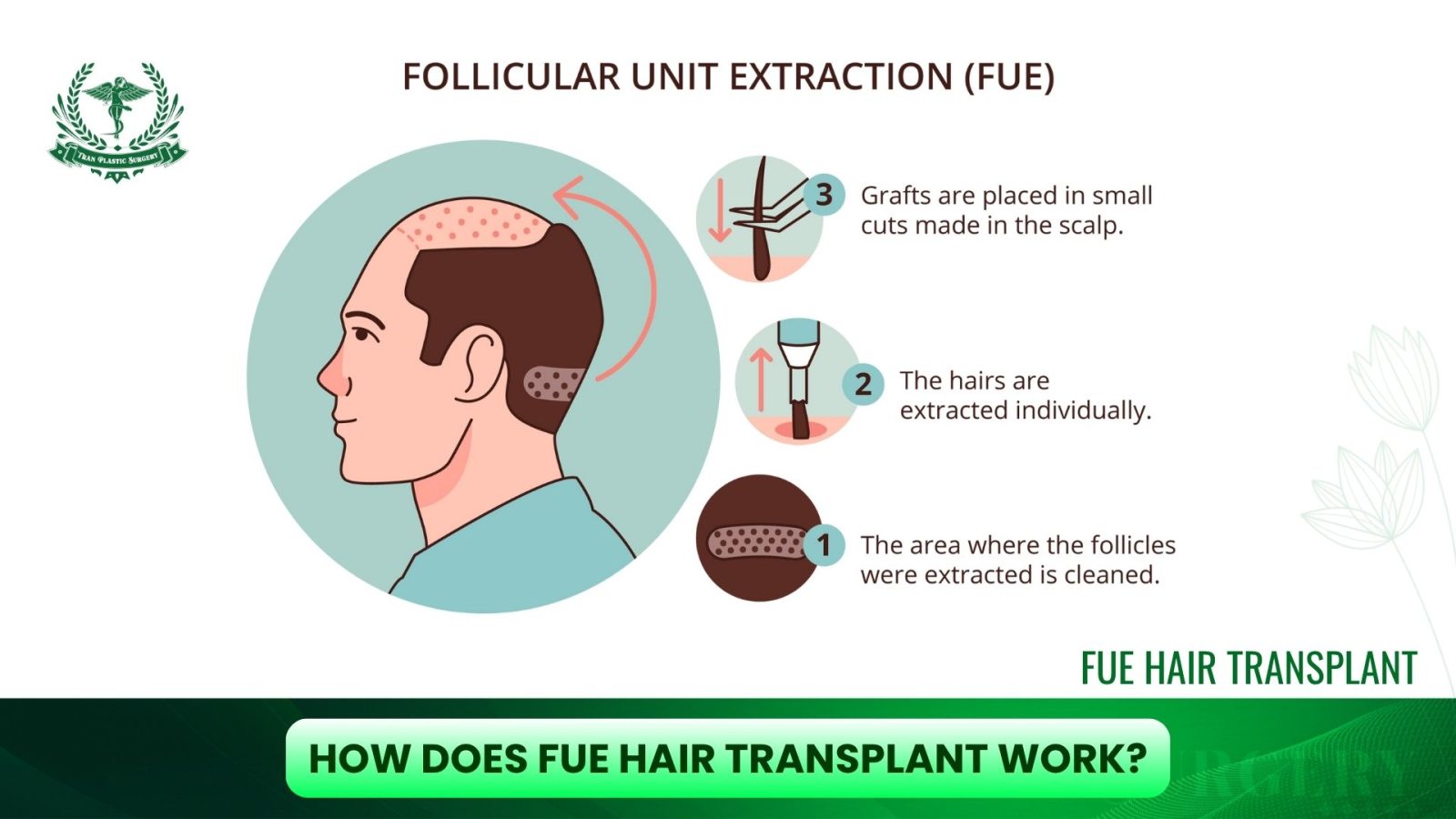
The FUE Hair Transplant procedure at Tran Plastic Surgery combines precision, artistry, and proven long-term success. Every step of the FUE hair transplant process is carefully designed to deliver natural, permanent, and confidence-restoring results. Our board-certified team specializes in advanced FUE hair restoration surgery, helping patients achieve lasting transformations through expert technique and personalized care.
>>> Schedule your consultation today to begin your journey toward renewed confidence.
FUE vs. FUT vs. DHI Hair Transplant – Which Is Better?
Choosing the right hair transplant method is one of the most important decisions when planning your restoration journey. The three leading techniques today are FUE (Follicular Unit Extraction), FUT (Follicular Unit Transplantation), and DHI (Direct Hair Implantation). Each approach offers distinct benefits, and understanding their differences will help you make a confident, informed choice.
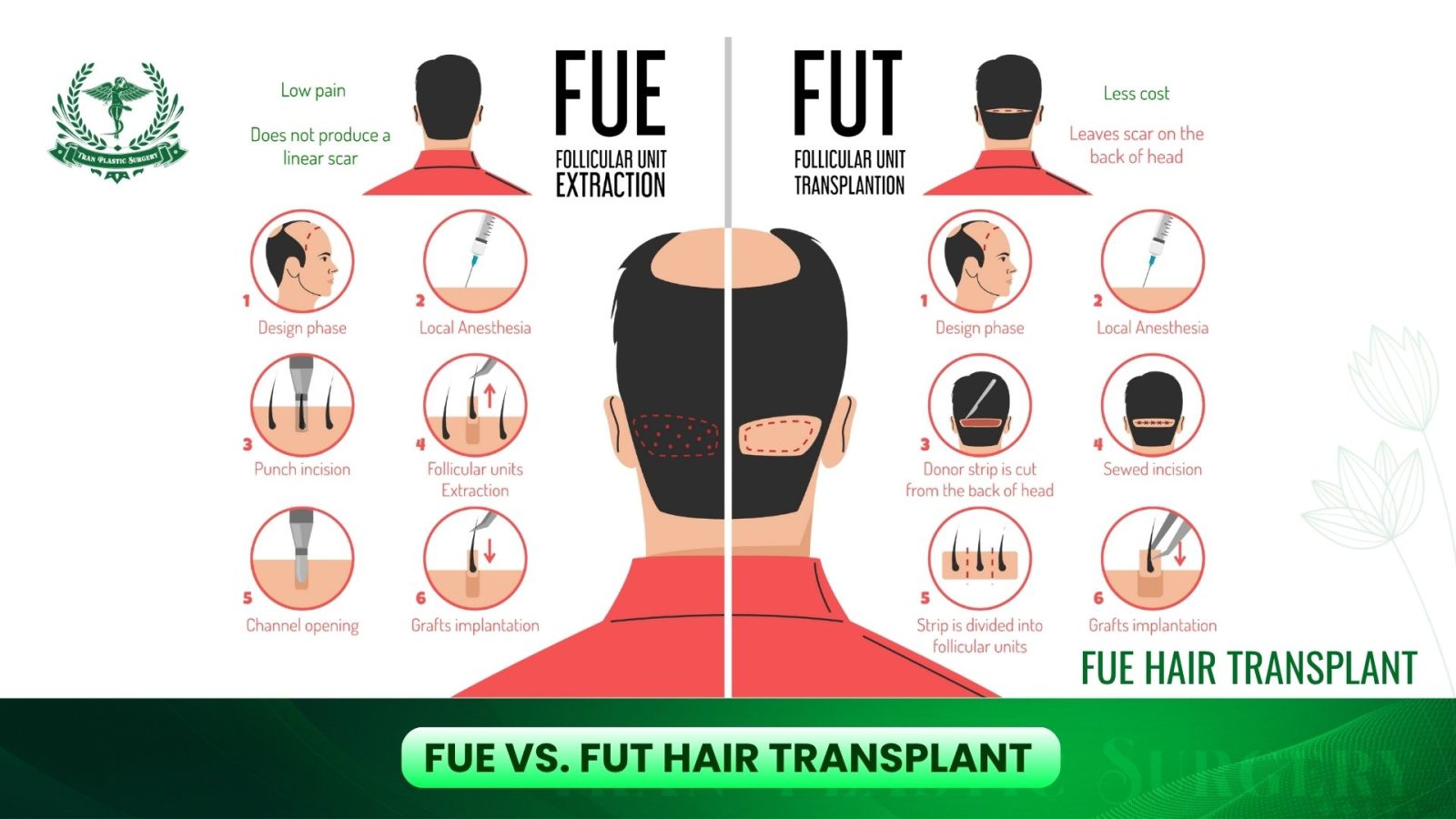
1. Comparing FUE, FUT, and DHI Techniques
| Feature | FUE | FUT | DHI |
| Scarring | Tiny, dot-like marks | Linear scar | Minimal |
| Healing Time | 7–10 days | 2–3 weeks | 5–7 days |
| Graft Yield | Moderate | High | Moderate |
| Procedure Time | 4–8 hours | 6–10 hours | 6–8 hours |
| Cost | Moderate | Lower | Higher |
| Best For | Men & women seeking natural results | Extensive baldness cases | Patients wanting high density & no shaving |
The fue vs fut hair transplant comparison highlights FUE’s advantage in comfort, minimal scarring, and faster recovery. In contrast, FUT may be suitable for those requiring a larger graft count. When comparing dhi vs fue hair transplant, DHI offers superior control in graft placement but often at a higher price point due to the technology and expertise required.
2. Which Technique Is Right for You?
The right choice depends on your scalp condition, hair density, lifestyle, and aesthetic goals. Patients seeking minimal downtime and invisible scarring often prefer FUE Hair Transplant, while those with extensive baldness might benefit from FUT. DHI, the most advanced method, is ideal for precise results in smaller or focused areas.
During your consultation, your surgeon will evaluate which method FUE, FUT, or DHI best matches your unique needs and desired outcome.
Benefits of FUE Hair Transplant
The FUE Hair Transplant technique offers a combination of medical precision, natural aesthetics, and patient comfort that makes it one of the most sought-after procedures in modern hair restoration. As a minimally invasive method, the FUE technique hair transplant provides long-term, natural-looking results without the discomfort or visible scarring associated with older techniques.
1. Natural and Permanent Results
One of the greatest benefits of FUE hair transplant is its ability to create a hairline that looks and feels completely natural. Each graft is placed with meticulous attention to direction, density, and angle, allowing new hair to blend seamlessly with existing strands. Because the transplanted follicles are your own, they continue to grow permanently, just like natural hair.
2. Minimal Scarring and Faster Recovery
Unlike FUT, which requires removing a strip of scalp, FUE leaves only tiny, dot-sized marks that are nearly invisible even with short hairstyles. Most patients experience mild redness that subsides within a few days, allowing them to return to work or social activities sooner. The absence of stitches also means less discomfort and a reduced risk of complications.
3. Versatile and Customizable
The FUE method is suitable for both men and women and can be performed on various areas of the scalp, beard, or even eyebrows. This versatility makes it ideal for patients with different levels of hair loss or specific aesthetic goals. Skilled surgeons can adjust graft density and pattern placement to ensure a balanced, natural look tailored to each individual.
4. Confidence-Boosting, Subtle Transformation
Beyond the physical improvements, many patients report a significant boost in self-esteem after the procedure. A fuller, healthier head of hair helps you look younger and feel more confident in personal and professional settings. Because the results develop gradually, the transformation appears completely natural to others.
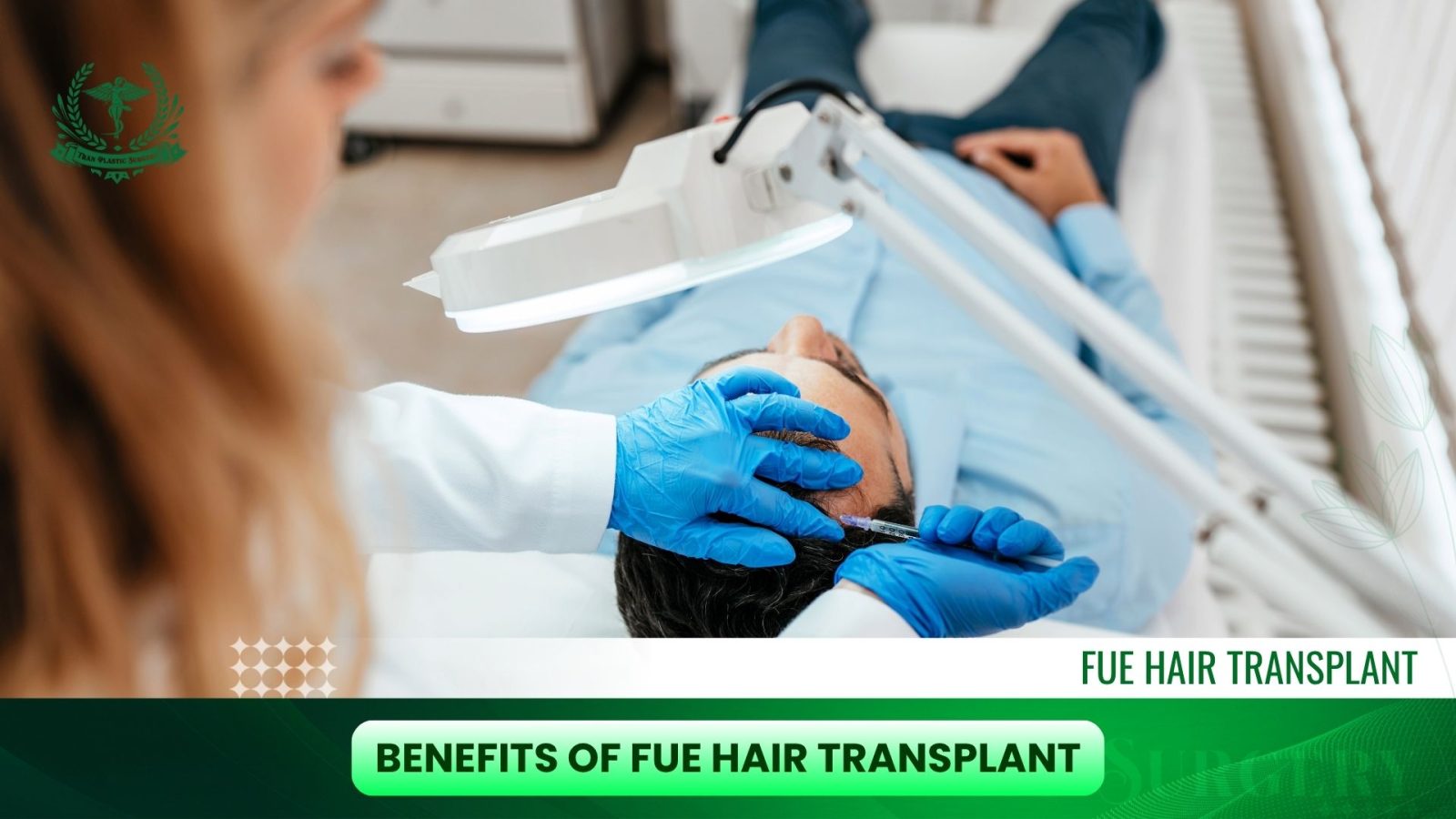
In summary, the FUE Hair Transplant stands out for its precision, safety, and artistry. It’s a trusted choice for those seeking natural restoration with minimal downtime proving why the FUE technique hair transplant has become the gold standard in modern hair restoration surgery.
Ideal Candidates for FUE Hair Transplant
Knowing who is suitable for FUE Hair Transplant helps ensure the best results. The ideal candidates are those with healthy donor hair, realistic expectations, and a desire for a permanent, natural-looking solution.
Patients with stable hair at the back or sides of the scalp are typically good candidates, as these areas provide strong follicles for transplantation. Both men and women with early-to-moderate hair loss can benefit from this method, especially those who prefer short hairstyles and want to avoid visible scarring.
Good overall health is also essential. Candidates should have no medical conditions that affect healing and must follow the surgeon’s aftercare instructions closely.
For those seeking a long-term, low-maintenance hair restoration option, an FUE Hair Transplant delivers natural, lifelong results that enhance both appearance and confidence.
FUE Hair Transplant Recovery Timeline
The FUE hair transplant recovery timeline is one of the most appealing aspects of this procedure. Healing is quick, downtime is short, and most patients can resume their daily activities within a few days. Here’s what to expect as your new hair begins to take shape.
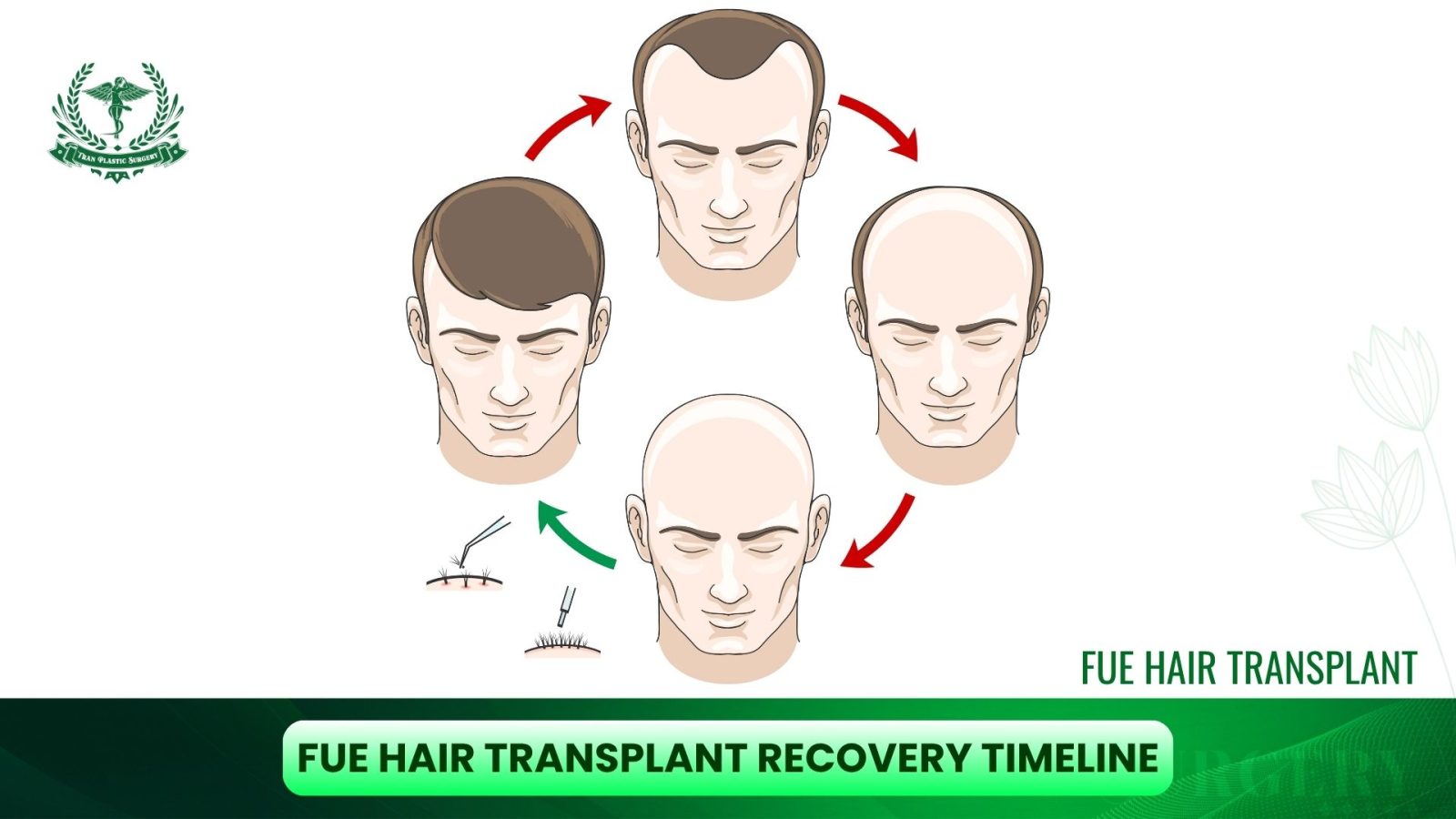
1. First Week
Within the first few days, tiny scabs may form around each graft. Mild redness and slight swelling are normal. Following your surgeon’s care instructions especially for washing and sleeping helps protect the grafts and ensures smooth healing.
2. Weeks 2–4
Around the second or third week, the transplanted hairs naturally shed. This is a temporary and expected stage in the recovery after FUE, as it signals that the follicles are entering a new growth cycle beneath the surface.
3. Months 2–4
Fine new hairs start to appear. They may look soft and thin at first, but over time they become stronger and thicker. Patients usually begin noticing the first visible improvements during this period.
4. Months 6–9
By six months, growth accelerates. The treated area fills in, density improves, and the overall texture of the hair becomes natural and even. This is when the transformation becomes clearly visible.
5. 12 Months and Beyond
After one year, the full results of your FUE Hair Transplant are typically complete. The new hair can be cut, styled, and washed just like natural hair because it is your own, permanently growing hair.
A smooth, confident recovery depends on consistent aftercare and patience. Every phase of the FUE hair transplant recovery timeline brings visible progress, leading to a permanent, natural-looking result that restores both hair and self-assurance.
FUE Hair Transplant Before and After Results
The most powerful proof of success from an FUE Hair Transplant comes from the transformation patients see in the mirror. Modern techniques allow for natural, seamless regrowth restoring not only hair but also self-confidence and youthful appearance. The gradual, authentic improvement ensures that the results look organic and never “surgical.”
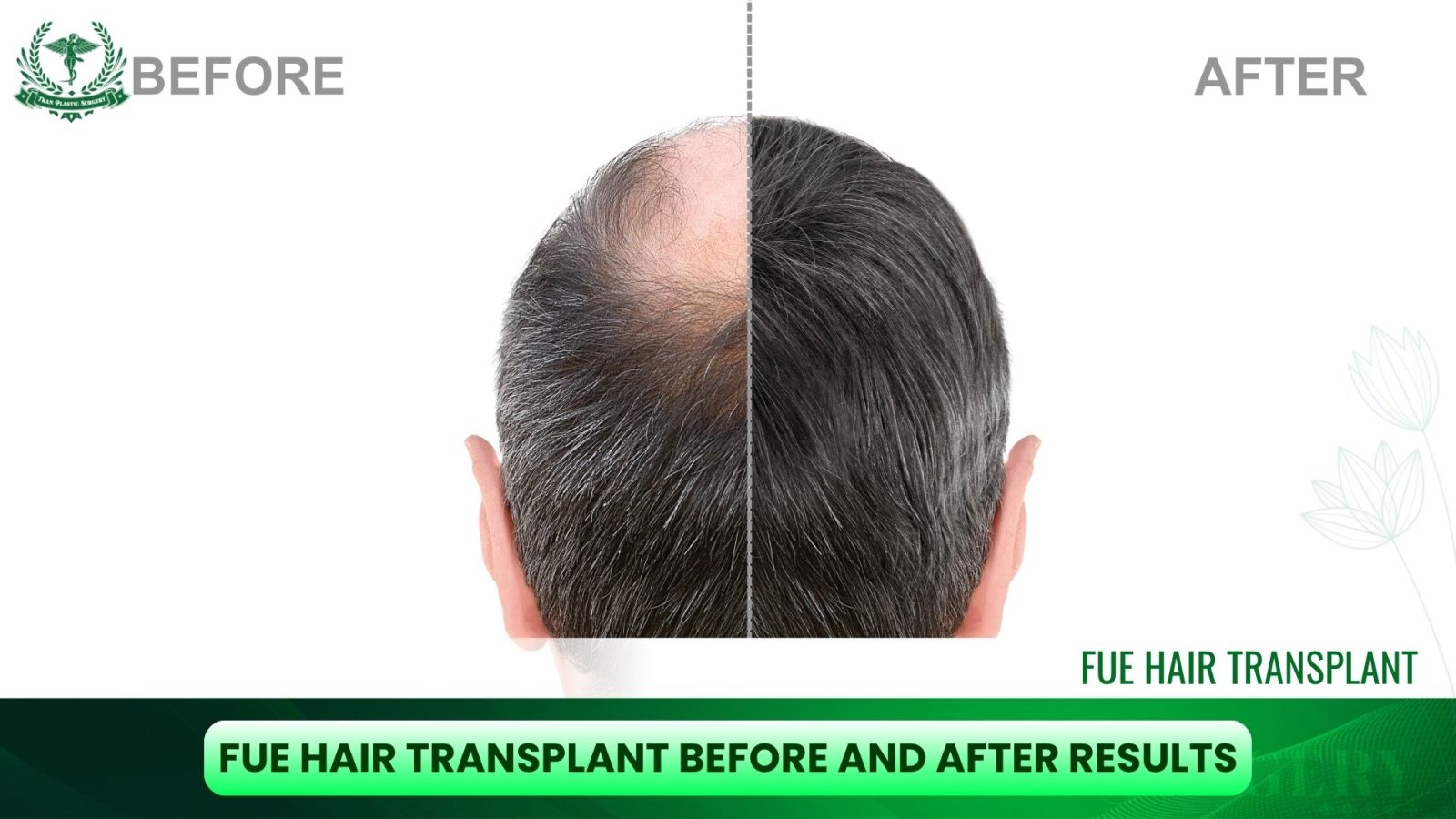
The fue hair transplant before and after difference typically becomes visible over several months. After surgery, transplanted follicles enter a short resting phase before new growth begins. Within three to four months, fine baby hairs start appearing. Noticeable thickness develops by month six, and by the 9–12 month mark, full results are generally visible.
1. Patient Testimonials and Confidence Restoration
Many patients describe the procedure as a life-changing experience. Along with regaining natural hair, they regain confidence in personal and professional interactions. Authentic testimonials, supported by real images, help potential patients trust the process and your clinic’s expertise.
John M., 38
“After my FUE Hair Transplant, I finally recognized myself in the mirror again. My hairline looks natural, and no one, not even my barber can tell I had surgery. It’s the best investment I’ve ever made.”
Ravi S., 34
“The results exceeded my expectations. The density looks incredible, and recovery was faster than I imagined. Seeing my ‘before and after’ photos still amazes me every day.”
Carlos G., 41
“I chose FUE because I wanted a scar-free procedure. Twelve months later, my confidence is back, and I feel ten years younger. The process was smooth from consultation to recovery.”
Michael D., 29
“My biggest fear was that it would look fake. But my surgeon designed a natural hairline that matches my face perfectly. Friends just think I changed my hairstyle!”
Ali K., 36
“I traveled for my FUE procedure after thorough research. The clinic’s professionalism impressed me, and the results are outstanding. I recommend it to anyone who’s hesitating. It truly changes how you feel about yourself.”
2. Long-Term Permanence
The transplanted follicles are resistant to hormonal hair loss, meaning the results of an FUE Hair Transplant are permanent. With proper care and healthy lifestyle choices, patients can maintain natural volume and density for decades.
The fue hair transplant before after transformation demonstrates how advanced this procedure has become. Patients can expect permanent, natural results that grow, move, and feel just like their original hair, a reflection of modern surgical artistry and precision.
Risks and Side Effects of FUE Hair Transplant
The FUE Hair Transplant is one of the safest and most refined procedures in modern hair restoration. When performed by an experienced, board-certified surgeon, complications are rare and typically mild. However, understanding potential fue hair transplant risks and side effects allows patients to make well-informed, confident decisions before undergoing treatment.
- Common and Temporary Side Effects
Mild side effects are normal and usually resolve within days after the procedure. These reactions are part of the body’s natural healing process and indicate healthy recovery.
- Redness and Swelling: Slight redness or swelling around the donor and recipient areas is common in the first few days. It typically subsides within 5–7 days.
- Scalp Sensitivity or Itching: Some patients experience temporary itching or tenderness as the scalp heals. Using recommended medicated shampoos and avoiding scratching will prevent irritation.
- Tiny Scabs and Flaking: Small crusts may form where follicles were implanted. They naturally fall off within 10–14 days as the new grafts stabilize.
- Shock Loss: Some transplanted hairs may shed temporarily within the first month. This is a normal response as follicles enter a rest phase before regrowth begins.
2. Less Common Risks
Though uncommon, certain issues can occur if post-procedure care is not followed or if the procedure is performed by unqualified practitioners.
- Infection or Folliculitis: Rare infections may occur if proper hygiene or aftercare instructions are neglected. These can be easily managed with antibiotics prescribed by your surgeon.
- Uneven Hair Growth: Inexperienced handling can cause uneven density or unnatural hairline patterns. Choosing a skilled surgeon minimizes this risk.
- Poor Graft Survival: Graft viability depends on precise extraction, preservation, and implantation. Reputable clinics use advanced tools and sterile techniques to maximize survival rates.
- Numbness or Tingling: Temporary numbness may occur near the donor area. It typically resolves within a few weeks as the nerves regenerate.
3. How to Minimize FUE Hair Transplant Risks
- Choose a Certified Surgeon: Select a clinic specializing in FUE with proven experience and patient testimonials.
- Follow Post-Operative Instructions: Proper care, gentle washing, and avoiding direct sun exposure accelerate recovery.
- Avoid Smoking and Alcohol: These slow the healing process and can affect graft survival.
- Use Prescribed Medications: Follow your surgeon’s medication plan to reduce inflammation and prevent infection.
Why is FUE considered a safe procedure? When performed by a qualified specialist, the FUE Hair Transplant carries minimal risk. The absence of large incisions or stitches reduces trauma, while modern sterilization and extraction methods ensure optimal safety. Compared to older techniques, FUE offers faster healing, less discomfort, and highly predictable outcomes. By choosing an experienced surgeon and adhering to proper aftercare, patients can expect a safe procedure and long-lasting, natural results.
Choosing the Right Surgeon for FUE Hair Transplant
Selecting the right expert for your FUE Hair Transplant is the most important step toward achieving natural, lasting results. The surgeon’s experience, precision, and artistic approach directly determine the quality of your outcome. What to look for in a qualified surgeon:
- Choose a surgeon certified by reputable organizations such as ISHRS, ABHRS, or ASPS.
- Opt for professionals who perform FUE procedures regularly and can show proven results.
- A trustworthy doctor explains every stage clearly from evaluation and cost to recovery.
- Great results depend on a surgeon’s ability to craft a realistic, age-appropriate hairline.
Why does expertise matter? An experienced hair surgeon delivers results that look natural and last for years. While cost matters, the value of expertise, precision, and safety far outweighs choosing a cheaper, less-qualified provider. Ready to restore your confidence? Learn more about Dr. Tuan Tran, board-certified plastic surgeon at Tran Plastic Surgery, trusted for natural, lasting FUE hair transplant results.
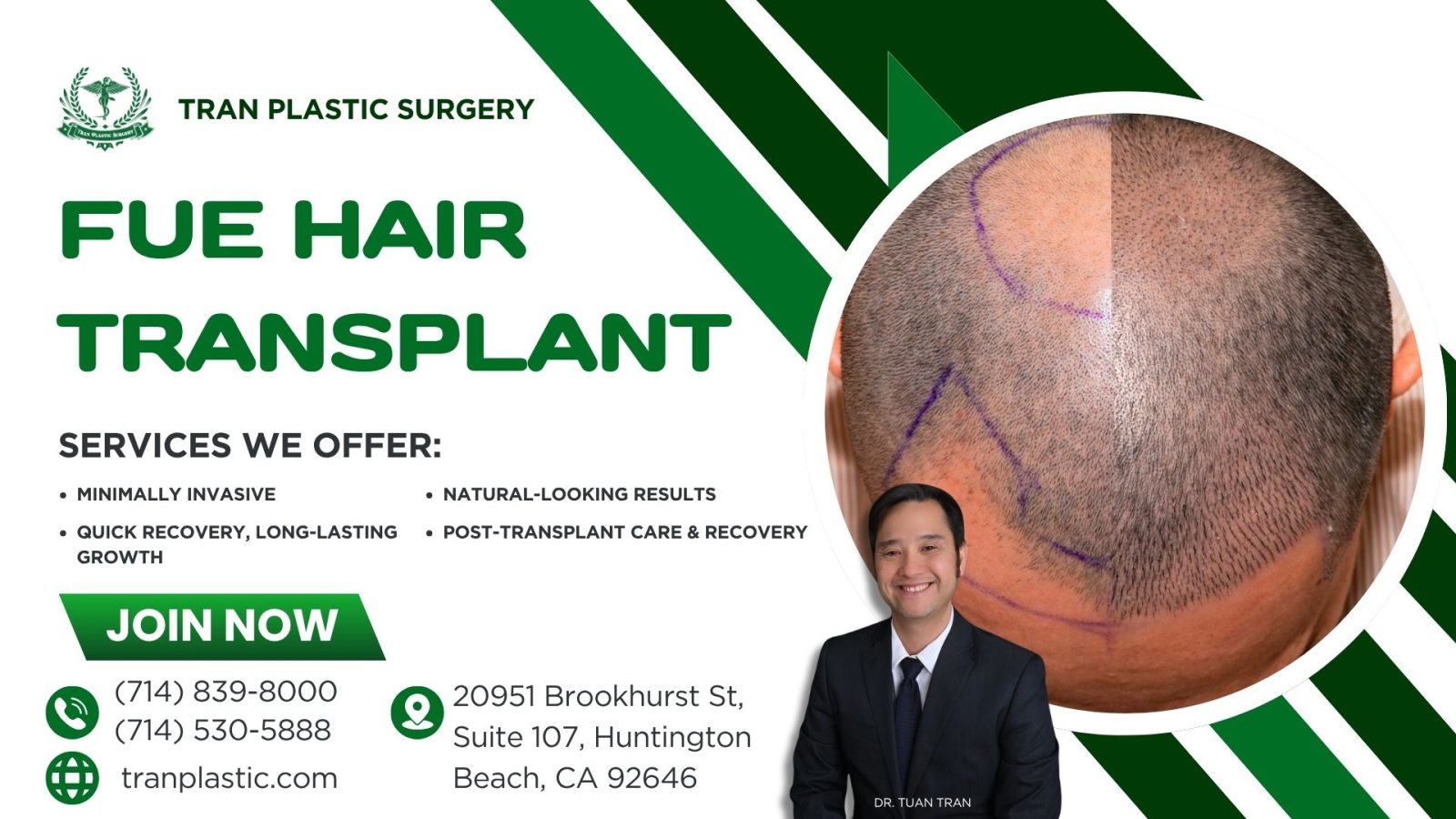
The best FUE hair transplant in USA clinics combine medical excellence with artistry. When researching, check surgeon credentials, patient reviews, and before-and-after galleries. Clinics with transparent communication and consistent results are your safest choice.
FAQs About FUE Hair Transplant
1. Is FUE Hair Transplant Permanent?
Yes. The results of an FUE Hair Transplant are permanent because the transplanted follicles are taken from areas resistant to genetic hair loss. Once implanted, these hairs continue to grow naturally for life. However, maintaining scalp health and following post-operative care instructions help preserve the best long-term outcome.
2. Does FUE Hair Transplant Hurt?
The FUE procedure is performed under local anesthesia, so patients do not feel pain during the surgery. Mild soreness or tightness may occur for a few days after the procedure, but it is temporary and manageable with prescribed pain relief. Most patients describe the experience as “mildly uncomfortable but not painful.”
3. How Long Does an FUE Hair Transplant Take?
An FUE Hair Transplant typically takes 4 to 8 hours, depending on the number of grafts needed and the size of the treatment area. Larger sessions may be divided over two days to ensure precision and comfort.
4. How Long Does It Take to See Results After FUE Hair Transplant?
Visible improvement begins around 3 to 4 months after surgery as new hairs start to grow. Noticeable thickness appears by 6 to 8 months, and final results—with full density and texture—are usually seen between 9 and 12 months post-procedure.
5. Is FUE Hair Transplant Safe?
Yes. The FUE technique is one of the safest hair restoration methods available. It involves no large incisions, minimal scarring, and quick healing. When performed by a certified and experienced surgeon, the risk of complications is extremely low.
6. Who Is the Best Candidate for FUE Hair Transplant?
Ideal candidates are individuals with healthy donor hair at the back or sides of the scalp, good overall health, and realistic expectations. Both men and women with early to moderate hair loss can benefit greatly from the FUE technique.
7. How Much Does FUE Hair Transplant Cost?
In 2025, the FUE Hair Transplant cost ranges from $2,000–$8,000 internationally (especially in countries like Turkey) and $4,000–$17,000+ in the U.S. The final price depends on the number of grafts, surgeon’s expertise, and clinic technology.
8. How Soon Can I Return to Work After the Procedure?
Most patients return to work within 3 to 5 days after surgery. However, strenuous exercise or heavy lifting should be avoided for at least two weeks to ensure proper healing.
9. Can Women Get a FUE Hair Transplant?
Absolutely. The FUE Hair Transplant technique is highly effective for both men and women, especially for treating thinning hair, receding hairlines, or patchy areas caused by hormonal or genetic factors.

